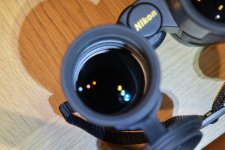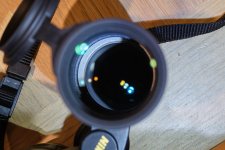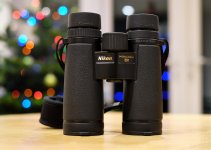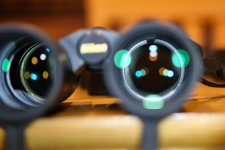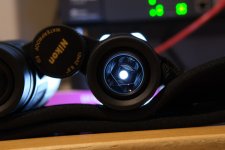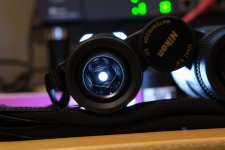Season's greetings to all. New poster here. I'm after some advice, if I may. I bought a new pair of Nikon Monarch HG 10x42s a few days before Christmas. I've taken them out three times so far and they're everything I hoped they'd be, so that's great.
However, when inspecting the barrel interiors yesterday, I noticed that both barrels had un-coated grey rings, one of which was significantly off-centre (please see attached photos). A quick Google search highlighted the allbinos.com review of the same model in which the reviewer notes the following about the reviewed pair:
I don't know what a "prism rim" looks like when viewed down a barrel, but I'm wondering if it's the same thing I'm seeing. Although the Monarchs are classed as "outstanding" in that review, the reviewer nevertheless notes that the exit pupils (the left one in particular it appears) are "unfortunately a bit truncated". The reviewer doesn't make a connection between the protruding prism rim and the exit pupil truncation, but I'm wondering if the former could be the cause of the latter and if any of the optics experts on this forum could advise? Perhaps truncated exit pupils are caused only by the configuration of the the eyepieces themselves and would not be affected by anything in the prisms or barrels, I don't know.
Anyway, if people here feel that the protruding ring is likely to be causing significant optical issues, I'll return the bins and request a replacement from the retailer. I can't say that I've noticed any problems with the view through the affected eyepiece and barrel, and I know that these aren't "Alpha" grade binoculars, but I bought them (partly, at least) in an attempt to avoid the worst of the problems caused by the hit-and-miss manufacturing standards that afflict many cheaper models and so feel a bit miffed that something in the barrel appears to have been so shoddily assembled.
I gave up trying to light the interior of the barrel evenly and so I settled on two views of the wonky grey ring, one of its less protruding side and one from the opposite. I hope it illustrates the issue. The third image is just a shot of the Monarch HGs for the benefit of anyone who hasn't seen a pair and is wondering what they look like
However, when inspecting the barrel interiors yesterday, I noticed that both barrels had un-coated grey rings, one of which was significantly off-centre (please see attached photos). A quick Google search highlighted the allbinos.com review of the same model in which the reviewer notes the following about the reviewed pair:
"Black tubes, quite matt and very strongly baffled. Black bottom but a prism rim sticks out and it is made of gray metal, not covered by anything at all. Very clear interior."
I don't know what a "prism rim" looks like when viewed down a barrel, but I'm wondering if it's the same thing I'm seeing. Although the Monarchs are classed as "outstanding" in that review, the reviewer nevertheless notes that the exit pupils (the left one in particular it appears) are "unfortunately a bit truncated". The reviewer doesn't make a connection between the protruding prism rim and the exit pupil truncation, but I'm wondering if the former could be the cause of the latter and if any of the optics experts on this forum could advise? Perhaps truncated exit pupils are caused only by the configuration of the the eyepieces themselves and would not be affected by anything in the prisms or barrels, I don't know.
Anyway, if people here feel that the protruding ring is likely to be causing significant optical issues, I'll return the bins and request a replacement from the retailer. I can't say that I've noticed any problems with the view through the affected eyepiece and barrel, and I know that these aren't "Alpha" grade binoculars, but I bought them (partly, at least) in an attempt to avoid the worst of the problems caused by the hit-and-miss manufacturing standards that afflict many cheaper models and so feel a bit miffed that something in the barrel appears to have been so shoddily assembled.
I gave up trying to light the interior of the barrel evenly and so I settled on two views of the wonky grey ring, one of its less protruding side and one from the opposite. I hope it illustrates the issue. The third image is just a shot of the Monarch HGs for the benefit of anyone who hasn't seen a pair and is wondering what they look like




